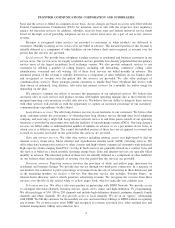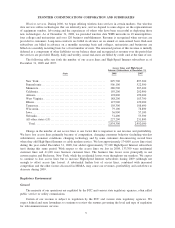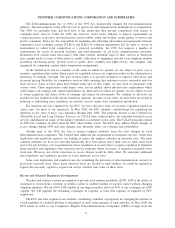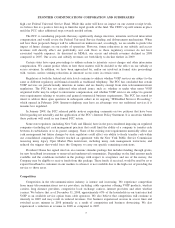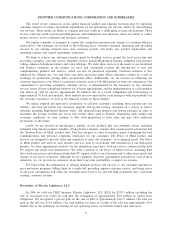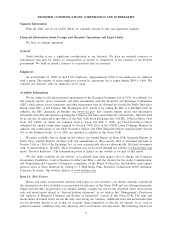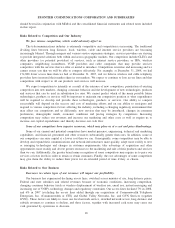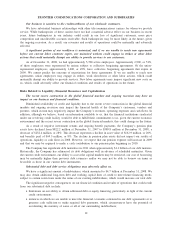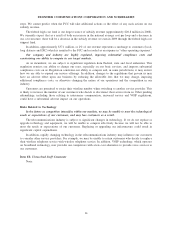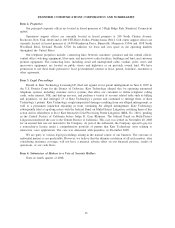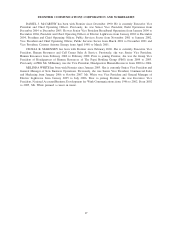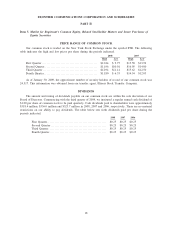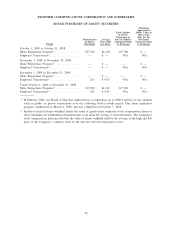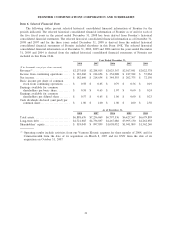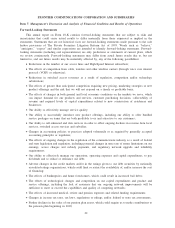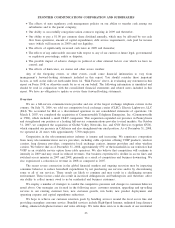Frontier Communications 2008 Annual Report Download - page 15
Download and view the complete annual report
Please find page 15 of the 2008 Frontier Communications annual report below. You can navigate through the pages in the report by either clicking on the pages listed below, or by using the keyword search tool below to find specific information within the annual report.steps. We cannot predict when the FCC will take additional actions or the effect of any such actions on our
subsidy revenue.
The federal high cost fund is our largest source of subsidy revenue (approximately $20.8 million in 2008).
We currently expect that as a result of both an increase in the national average cost per loop and a decrease in
our cost structure, there will be a decrease in the subsidy revenue we earn in 2009 through the federal high cost
support fund.
In addition, approximately $37.1 million, or 2% of our revenue represents a surcharge to customers (local,
long distance and IXC) which is remitted to the FCC and recorded as an expense in “other operating expenses.”
Our company and industry are highly regulated, imposing substantial compliance costs and
constraining our ability to compete in our target markets.
As an incumbent, we are subject to significant regulation from Federal, state and local authorities. This
regulation restricts our ability to change our rates, especially on our basic services, and imposes substantial
compliance costs on us. Regulation constrains our ability to compete and, in some jurisdictions, it may restrict
how we are able to expand our service offerings. In addition, changes to the regulations that govern us may
have an adverse effect upon our business by reducing the allowable fees that we may charge, imposing
additional compliance costs, or otherwise changing the nature of our operations and the competition in our
industry.
Customers are permitted to retain their wireline number when switching to another service provider. This
is likely to increase the number of our customers who decide to disconnect their service from us. Other pending
rulemakings, including those relating to intercarrier compensation, universal service and VOIP regulations,
could have a substantial adverse impact on our operations.
Risks Related to Technology
In the future as competition intensifies within our markets, we may be unable to meet the technological
needs or expectations of our customers, and may lose customers as a result.
The telecommunications industry is subject to significant changes in technology. If we do not replace or
upgrade technology and equipment, we will be unable to compete effectively because we will not be able to
meet the needs or expectations of our customers. Replacing or upgrading our infrastructure could result in
significant capital expenditures.
In addition, rapidly changing technology in the telecommunications industry may influence our customers
to consider other service providers. For example, we may be unable to retain customers who decide to replace
their wireline telephone service with wireless telephone service. In addition, VOIP technology, which operates
on broadband technology, now provides our competitors with a low-cost alternative to provide voice services to
our customers.
Item 1B. Unresolved Staff Comments
None.
14
FRONTIER COMMUNICATIONS CORPORATION AND SUBSIDIARIES


